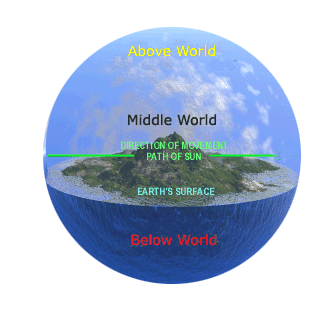Origins of the Middle World
To answer this question, Indians turn to stories that have been passed from generation to generation, since time began. Some of us may refer to these stories as myths. This is a poor term because in modern society the word “myth” usually refers to an account that is not factual but is instead based on misconceptions or fantasy. In many non-western societies, mythic stories are regarded not as false or fantastic but as the highest form of truth. Even where key story themes are obviously metaphorical, the story’s most essential components are considered to bear a close relationship to real world events, circumstances, and processes. One of our objectives is to find out how this works. Stories that tell how the world came to be, how it is organized, and how it operates, are of two kinds. The first are primary accounts that relate the creation of the world along with the first people, animals, and plants. Then there are secondary accounts, derived from the primary stories, that tell about subsequent creations and events that established the way things are in the present world. The sections that follow contain a series of primary and secondary creation stories that tell how the Southeastern Indian world came to exist. Additional comments connecting these stories into an overall narrative are provided. The sources for the stories are identified below.
|
|
 |

|
 Indians of Arkansas and the South live in a universe consisting of three layers: an Above World associated with creative forces, perfect spirit beings, and the souls of ancestors; a Middle World inhabited by human, plant, and animal communities; and a Below World associated with destructive forces and imperfect spirit beings. How were these worlds created?
Indians of Arkansas and the South live in a universe consisting of three layers: an Above World associated with creative forces, perfect spirit beings, and the souls of ancestors; a Middle World inhabited by human, plant, and animal communities; and a Below World associated with destructive forces and imperfect spirit beings. How were these worlds created?